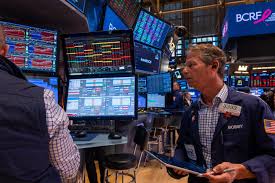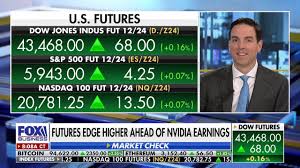Dow Jones Stock Futures: What Investors Must Know Today
Dow Jones Stock Futures: What Investors Must Know Today
When it comes to global markets, Dow Jones stock futures are one of the most closely watched indicators of how Wall Street might perform when the opening bell rings. Every morning, investors, traders, and financial analysts refresh their screens to see if Dow futures are pointing up or down — because it sets the tone for the trading day. In this detailed guide, we’ll break down what Dow Jones stock futures mean, why they matter, and how you can use them to make smarter investment decisions.

What Are Dow Jones Stock Futures?
Dow Jones stock futures are contracts that allow investors to buy or sell the Dow Jones Industrial Average (DJIA) at a predetermined price on a future date. The Dow Jones itself is made up of 30 major U.S. companies — names like Apple, Microsoft, Boeing, and Goldman Sachs. The futures market, however, lets investors speculate on where the index will go before the stock market actually opens.
For instance, if Dow Jones stock futures are rising before the opening bell, it often signals optimism in the market. Conversely, when futures drop, traders expect a weaker session.
Why Dow Jones Stock Futures Matter
The importance of Dow Jones stock futures can’t be overstated. They serve as a barometer of investor sentiment, giving an early indication of how economic data, earnings reports, or geopolitical events might affect markets. Futures trading takes place nearly 24 hours a day, allowing investors to respond to breaking news even when the New York Stock Exchange is closed.
This round-the-clock trading window means that Dow futures react instantly to global developments — whether it’s an interest rate announcement from the Federal Reserve or fresh inflation data from the Bureau of Labor Statistics.
How Dow Jones Futures Influence Global Markets
Because the U.S. market is so influential, Dow Jones stock futures have a ripple effect across global markets. When Dow futures plunge, it often drags down European and Asian stocks, and vice versa. For example, if U.S. futures rise after strong corporate earnings, optimism tends to spread across the world.
Investors use Dow futures to gauge risk appetite — whether the market is feeling bullish (optimistic) or bearish (pessimistic). Big hedge funds, institutional investors, and even retail traders keep their eyes glued to these movements.
Key Factors That Move Dow Jones Stock Futures
Several factors can cause significant swings in Dow Jones futures. Understanding these can help investors predict short-term market trends:
- Economic Data: Reports like unemployment numbers, inflation rates, and consumer confidence indexes can shift market sentiment overnight.
- Federal Reserve Policies: Changes in interest rates or hawkish/dovish comments from the Fed have immediate impacts on futures.
- Corporate Earnings: Strong quarterly reports can boost futures, while disappointing results tend to drag them down.
- Geopolitical Tensions: Conflicts, trade wars, or global political instability can trigger fear-driven selloffs.
- Technological & Energy Sectors: As tech and energy stocks form a major portion of the Dow, movements in these industries heavily affect futures prices.
How Traders Use Dow Jones Stock Futures
Professional traders often use Dow Jones stock futures for hedging and speculation. If they expect the market to rise, they may buy futures contracts to lock in gains. On the other hand, if they anticipate a downturn, they can short futures to protect their portfolios.
Even long-term investors use futures as a risk management tool to minimize losses during volatile periods. For example, if you hold a large amount of blue-chip stocks, you might short Dow futures to offset potential losses during an economic slowdown.
Dow Jones Futures vs. S&P 500 and Nasdaq Futures
While Dow Jones futures track 30 large industrial and tech companies, S&P 500 futures represent a broader mix of 500 companies, and Nasdaq futures focus mainly on technology-driven firms. Investors often monitor all three indices together for a complete picture of market direction.
However, the Dow is unique because it’s price-weighted, meaning companies with higher stock prices influence the index more — even if they aren’t the largest by market cap. This gives Dow Jones stock futures a distinctive movement pattern compared to its peers.
Current Trends in Dow Jones Stock Futures (2025 Outlook)
As we move through 2025, Dow Jones stock futures are reflecting a market cautiously optimistic about economic recovery and cooling inflation. Analysts expect moderate growth driven by strong consumer spending, tech innovation, and potential interest rate cuts from the Fed.
Investors are particularly watching sectors like:
- Technology: AI and semiconductor growth continue to power the market.
- Energy: Renewable energy and oil fluctuations influence Dow components like Chevron.
- Finance: Banks benefit from stable rates and strong credit performance.
If inflation remains under control and global tensions ease, Dow Jones stock futures could see bullish momentum through the next quarter.

Expert Tips for Trading Dow Jones Stock Futures
- Stay Updated: Watch real-time data and economic calendars for updates that affect the market.
- Use Stop-Loss Orders: Manage risk effectively to avoid large losses during volatile sessions.
- Diversify Your Portfolio: Don’t rely solely on Dow futures — include other indices and assets.
- Avoid Emotional Trading: Stick to your strategy, and don’t let short-term moves cloud long-term goals.
Final Thoughts: Is Now the Time to Watch Dow Jones Stock Futures?
Absolutely. With markets reacting swiftly to every Fed statement and global event, Dow Jones stock futures remain one of the most powerful tools for forecasting market direction. Whether you’re a professional investor or a curious beginner, keeping an eye on these futures gives you an edge in understanding where the market is heading.
By learning how Dow futures behave and what drives them, you can position your investments more intelligently — and potentially ride the next big rally with confidence.
Keywords: Dow Jones stock futures, Dow Jones futures today, Dow Jones Industrial Average, US stock market, stock futures trading, financial markets, Wall Street futures.
